ZEROtherm Nirvana: Designed for Top Performance
by Wesley Fink on January 16, 2008 5:00 PM EST- Posted in
- Cases/Cooling/PSUs
In the earlier review of the ZEROtherm BTF90 we were somewhat amused by the butterfly shape of the cooler with a 90mm fan. The shape appeared more a gimmick than anything that could improve performance, so we really didn't expect much from the cooler. However, the performance of that upper mid-range cooler was anything but laughable. Cooling performance was very solid, leading to the conclusion that "...this butterfly carries a pretty good punch, yet the sting is nearly silent - just the way we like it." That review posted last August, and since then ZEROtherm has been hard at work on a larger cooler aimed at the top of the cooler performance charts.
The new ZEROtherm Nirvana does not look like a butterfly, but the influence of the original butterfly-shaped BTF90 is clearly there in the cooling fin design. That is certainly a good thing if Nirvana works as well at the top of the cooling heap as BTF90 did for the less expensive 90mm mid-range coolers.
For those not familiar with ZEROtherm, it is the marketing division of a company called APACK, a company known more for targeting the OEM market. Since the success of Zalman as a cooling company based in Korea, other Korean companies have aimed for a slice of the enthusiast cooling pie. APACK is one of those companies who manufactures in Korea, and the ZEROtherm division is dedicated to marketing enthusiast level cooling solutions.
APACK was established in 1999 by three engineers from ETRI (Electrics and Telecommunications Research Institute) with extensive experience in thermal solutions and advanced packaging design (packaging meaning integration of multiple technologies). Based in the city of Daejeon (in the Korean Silicon Valley), APACK is still mainly an engineering company. Phase one of APACK's growth was producing OEM solutions for companies like Samsung, Dell, and LG. ZEROtherm is part of phase two, which is direct marketing of APACK thermal solutions.
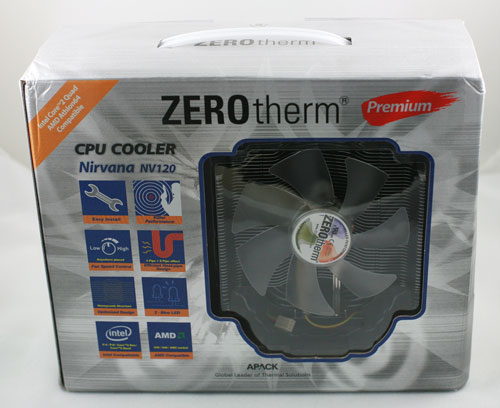
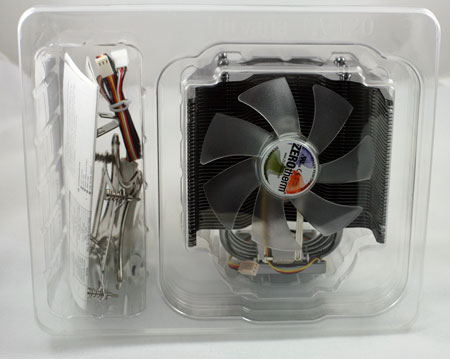
As the Nirvana builds on the success of the BTF90, it is no surprise that the packaging uses the same basic silver background and color scheme as the BTF90. However, like the cooler itself, the Nirvana doesn't carry the theme quite as far. The package is more basic without the distinctive sloped sides used in the BTF90 packaging.
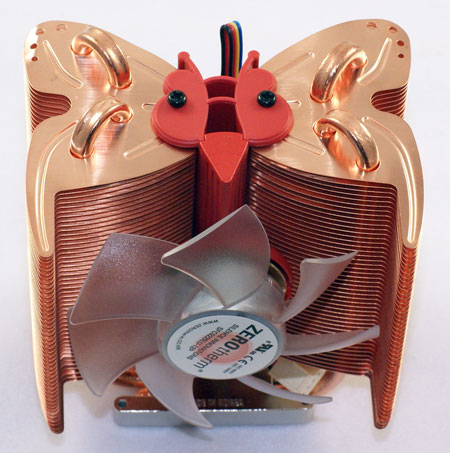
ZEROtherm BTF90
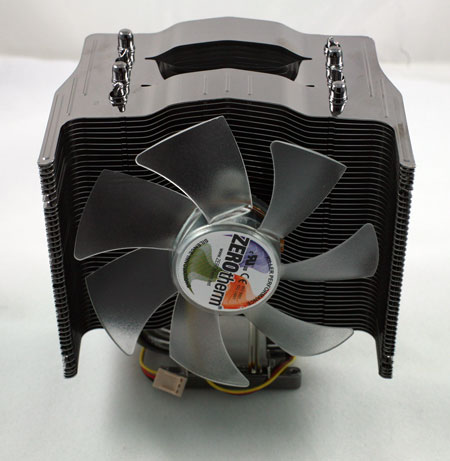
ZEROtherm Nirvana NV120
Inside the box you will find the fully assembled Nirvana NV120, including an integral and non-replaceable 120mm fan. The Nirvana uses the cooling fin shape that worked well on the BTF90, with the extensions that wrap around the fan. However, ZEROtherm did not highlight the butterfly shape as they did on the BTF90.
The smaller cooler was also all copper, where the Nirvana uses nickel-plated copper for the base and heatpipes. The Nirvana fins are aluminum and not pure copper as seen on the BTF90. Both coolers use four heatpipe loops, but the configurations are a bit different. The Nirvana is both larger and heavier than the BTF90 and it takes up more board and case real estate - hopefully with the result that it cools better.
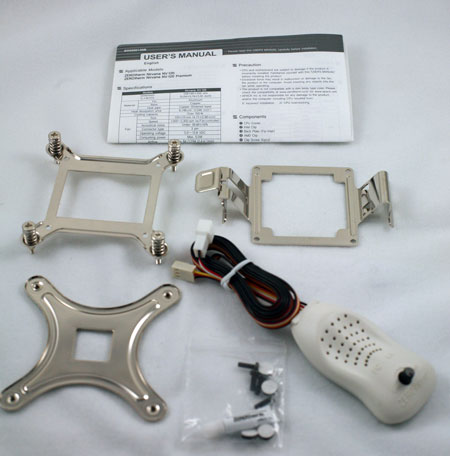
CPU and mounting options are very similar to the BTF90. Mounting hardware is included for Intel Socket 775 and AMD Socket 754/939/940/AM2. Also included is ZEROtherm thermal grease and a fan controller.
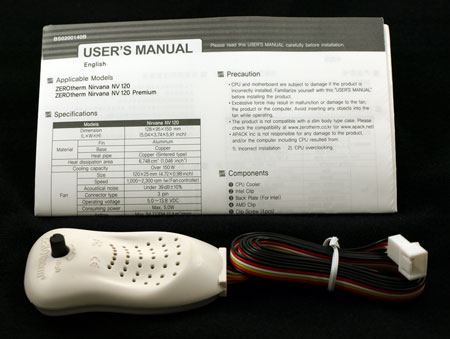
Also included in the Nirvana package are mounting screws and a multi-language user's manual. You get everything needed for installing the NV120 except a screwdriver.
The ZEROtherm Nirvana is an upgrade of the BTF90 to improve cooling with a 120mm fan and a larger, heavier cooler. Does the NV120 do what ZEROtherm intended? Is it a better cooler than the small and excellent BTF90?










38 Comments
View All Comments
Wesley Fink - Thursday, January 17, 2008 - link
It looks like we are going to have to do an article to educate readers on dBa sound levels. Noise does matter, but some of the fanatic quiet sites have completely distorted the meaning of noise levels so people no longer understand what they mean. 35 dBa is the noise level of a quiet suburban bedroom, away from traffic, at night. 45 dBa is considered a Quiet Room. Our sound floor in the new test environment is around this level. Our super quiet variable-fan-speed power supply is around this level at idle, but not while doing useful work. Unless you are running a fanless power supply measurements below this threshold are meaningless.Below is a chart from an acoustic engineering company. It is to help put in perspective what dBa sound levels actually mean.
190 dBA Heavy weapons, 10 m behind the weapon (maximum level)
180 dBA Toy pistol fired close to ear (maximum level)
170 dBA Slap on the ear, fire cracker explodes on shoulder, small arms
at a distance of 50 cm (maximum level)
160 dBA Hammer stroke on brass tubing or steel plate at 1 m distance,
airbag deployment very close at a distance of 30 cm (maximum level)
150 dBA Hammer stroke in a smithy at 5 m distance (maximum level)
130 dBA Loud hand clapping at 1 m distance (maximum level)
120 dBA Whistle at 1 m distance, test run of a jet at 15 m distance
Threshold of pain, above this fast-acting hearing damage in short action is possible
115 dBA Take-off sound of planes at 10 m distance
110 dBA Siren at 10 m distance, frequent sound level in discotheques and close
to loudspeakers at rock concerts, violin close to the ear of an orchestra
musicians (maximum level)
105 dBA Chain saw at 1 m distance, banging car door at 1 m distance (maximum level),
racing car at 40 m distance, possible level with music head phones
100 dBA Frequent level with music via head phones, jack hammer at 10 m distance
95 dBA Loud crying, hand circular saw at 1 m distance
90 dBA Angle grinder outside at 1 m distance
Over a duration of 40 hours a week hearing damage is possible
85 dBA 2-stroke chain-saw at 10 m distance, loud WC flush at 1 m distance
80 dBA Very loud traffic noise of passing lorries at 7.5 m distance,
high traffic on an expressway at 25 m distance
75 dBA Passing car at 7.5 m distance, un-silenced wood shredder at 10 m distance
70 dBA Level close to a main road by day, quiet hair dryer at 1 m distance to ear
65 dBA Bad risk of heart circulation disease at constant impact
60 dBA Noisy lawn mower at 10 m distance
55 dBA Low volume of radio or TV at 1 m distance, noisy vacuum cleaner at
10 m distance
50 dBA Refrigerator at 1 m distance, bird twitter outside at 15 m distance
45 dBA Noise of normal living; talking, or radio in the background
40 dBA Distraction when learning or concentration possible
35 dBA Very quiet room fan at low speed at 1 m distance
25 dBA Sound of breathing at 1 m distance
0 dBA Auditory threshold
mustardman - Tuesday, January 22, 2008 - link
Doesn't the chart list 35dBa as a "Very quiet room fan at 1m"? That's quite different than a quiet suburban bedroom. Everyone's threshold of annoying noise is different. I know I can not sleep with a fan, even low speed, in my room. So, a computer louder than that is unacceptable. Same reason I had to unplug my TiVo before sleeping. I eventually moved it out of the room.I'll check the other sites in addition to Anand, which I've been an avid reader for 8+ years.
strikeback03 - Thursday, January 17, 2008 - link
I'd guess checking over at Silent PC Review would be more useful for you then, that is the type of testing they do. Anandtech has typically tried to show how it will impact a more typical system, which has fans.The room noise level for the tests was listed as 35dB, so a 25dB system would be probably be considered silent.
mustardman - Tuesday, January 22, 2008 - link
Good point. I didn't see the room noise level. I guess they would be unable to test lower in that case.Cardio - Thursday, January 17, 2008 - link
Have this cooler and improved its performance by 1-3c with a little work. Bottom of heatsink is chrome plated like the rest of the cooler. Chrome is a poor heat transfer material. I removed the chrome by sanding with 200 grit wet/dry @ 100RPM on a varible speed rotating bench sander. Finishing with jewelers rouge on a sheeps wool buffer. Bottom plate is also much smoother as it was quite shiny before but showed some machine marks. Very pleased with cooler as it now achieves great results at even lower fan speed.can - Monday, January 21, 2008 - link
It's nickel, not chrome.DukeN - Thursday, January 17, 2008 - link
Why not included in any comparisons guys - this one is incredibly popular (and seems like a great bargain at ~ $25 or less)?Thanks.
aussiestilgar - Thursday, January 17, 2008 - link
I've been waiting for AnandTech to review this cooler. I like that the test setup is very consistent which makes it easy to compare different coolers. I own this cooler and I must say its fantastic. It cools like the best of them and is extremely good value!sotx - Thursday, January 17, 2008 - link
um... just wondering here...the result for the ultra extreme 120 are obtained with or without the fan(s)?
Wesley Fink - Thursday, January 17, 2008 - link
The Thermalright Ultra-120 Extreme was tested with the Scythe SFlex SFF21F 120mm fan. You can refer to the full review for test results by clicking on the cooling tab at the top of this page and searching for the 120 eXtreme review.Those results were run with our earlier test bed and the nVidia utility and they are not directly comparable to current test results. As we said in the review we retested the top coolers on our new test bed with CoreTemp and those are the reported results in this review.